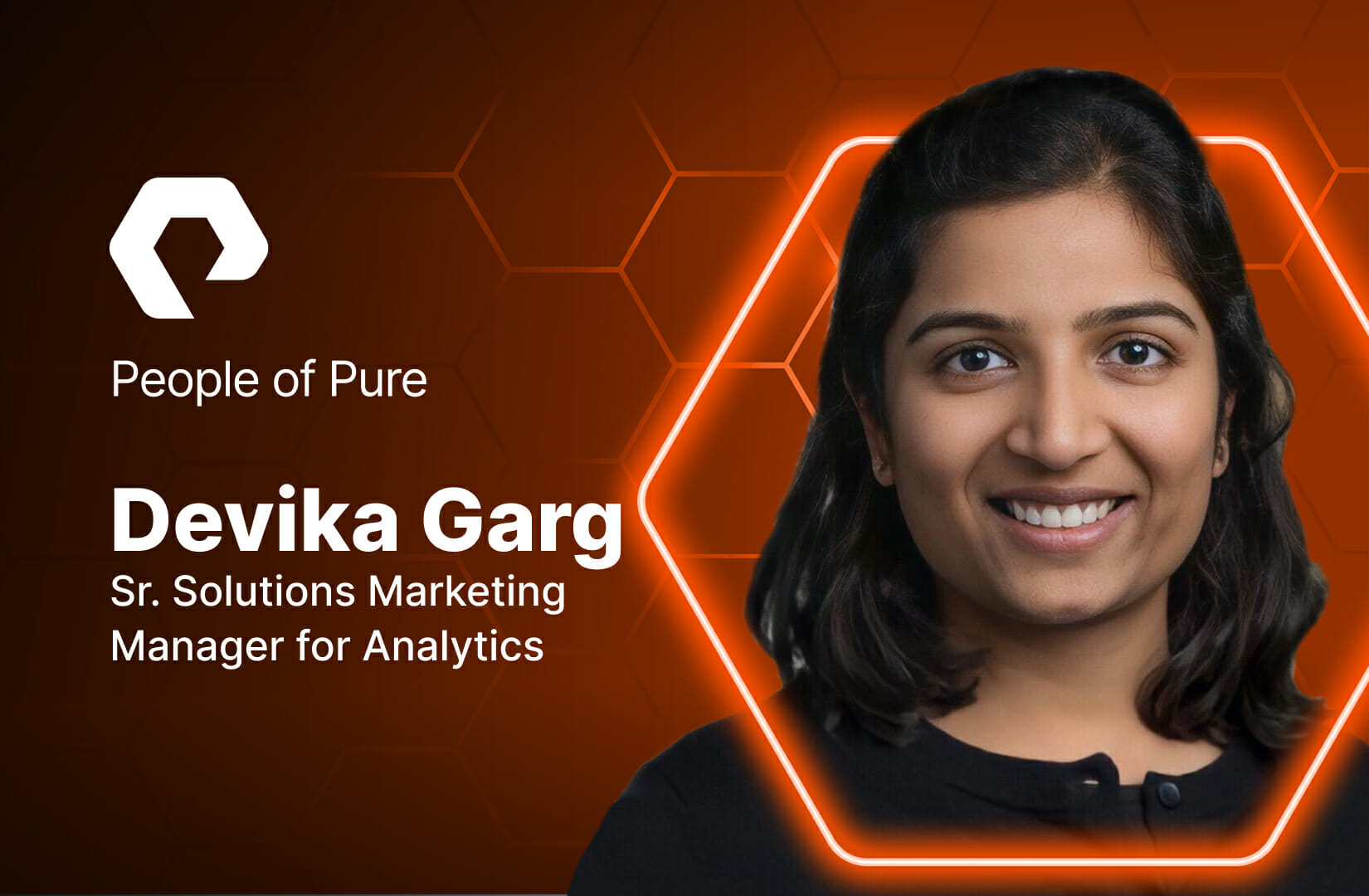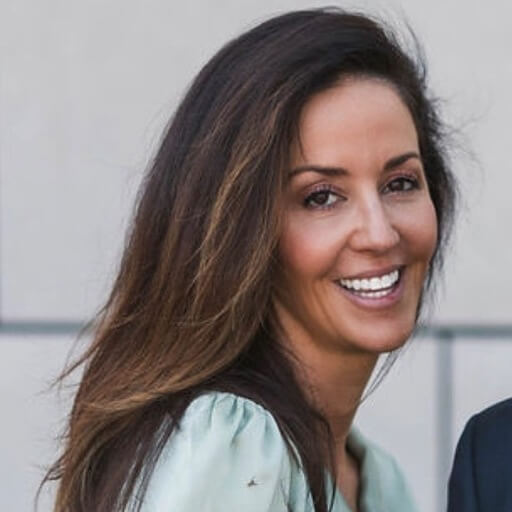Many careers are not a straight line, and that’s a good thing—especially when the individual brings rich, adjacent knowledge and skills to new roles and opportunities. It’s why Pure Storage is so lucky to have Devika Garg, a STEM master and mom of two, whose journey to Pure has made her the asset she is here today.
Learn more about her background, her passions, and how she sees data storage transforming the way we diagnose, treat, and prevent disease.
The Leap from STEM to Storage
One of the coolest things about Pure is our diverse backgrounds. We’re all in tech, but not all of us came from tech. And that’s a good thing. So what brought a life sciences doctorate to the data technology world?
“After I got my PhD, I did a post-doc and was working on identifying early genetic biomarkers for kidney disorders. At the time, a lot of that work was very early research that wouldn’t hit the market for 30 years,” Devika says. “As much as I love science, that process is slow and takes time, whereas I wanted to be in a fast-paced environment closer to the end user. I wanted to be closer to something that would make an impact right away.”
After spending some time in digital health, she saw how cross-functional the tech and science disciplines (STEM) were and also how much tech was picking up pace.
“Data has been permeating every single industry for a long time now,” Devika explains. “Five years ago, technology was really beginning to find its footing in the life sciences space.”
While startups made early headway to solve healthcare and life sciences problems, bigger tech companies have joined the movement in thoughtful ways. “Companies like Pure, Apple, and Google are now sharing solutions and products with unique capabilities to address healthcare problems with data analytics and AI.”
Check Out More People of Pure!
Coming Full Circle with Pure
Armed with undergrad engineering discipline and life sciences experience, she asked: “Let’s see what tech can bring to the table in this industry and how I can make a difference.”
She joined Pure’s Life Sciences Solutions Marketing team in May 2020, smack in the middle of the pandemic. “All my background is in life sciences and science journalism, so it really made a lot of sense to me. That role was a merging of everything I’d done up to that point; it was really cool.”
As the healthcare industry went through a rapid modernization, data took center stage. “I like to think of data centricity as the second renaissance for healthcare and life sciences; the first was in the 1940s when Schrödinger, a physicist, brought molecular thinking into biology and it changed everything,” she says. “Today, many big and small problems are easily solved through data analytics and AI.”
Data storage is fundamental to analytics, but many healthcare and life sciences organizations may not realize storage could be a hidden lever to drive success. “Most researchers look at storage tech as merely a means to store their EHR, genomics, or imaging data—the aha moment that storage choices can have an outsized impact on how quickly they can get to results is where the work lies,” Devika says, “It’s most exciting—connecting the dots and helping our customers get closer to a big breakthrough.”
Learn how Pure helps enable STEM leaders.
In Healthcare, Data Will Make the Difference
By August of 2022, Devika was ready to expand her role into something more broad, into analytics solutions marketing, diving into the world of log analytics, data warehouses, and data lakes, where the vast majority of analytics work happens across industries.
And themes across analytics are the same as they are in healthcare and life sciences: storage can sometimes be the forgotten piece within data infrastructure, but one that can arguably be the easiest knob to get to high performance and make a big difference in time to insights and competitive advantage.
*Editor’s note: True to Pure form, Devika’s manager at the time played a key role in her new opportunity. She shared: “When a role opened up on a new team, my prior manager was such a rockstar supporter. He saw the growth opportunity for me and really pushed me to go after it.”
Predictions for Healthcare Innovation
We couldn’t resist asking Devika to share some of the innovations between data and healthcare that she’s most excited about. We live in a really exciting time, she says, and analytics and AI are at the forefront:
- Drug development and testing. “AI and analytics are playing a huge role in the early drug development process and target identification spaces. Work that would otherwise be done in a wet lab, testing molecule by molecule, can be done so much faster. You can predict accuracy, you can simulate success rates—we’re even at a point where drugs can be designed using generative AI and get into the pipeline faster for development. It’s still maturing, but it’s happening fast.”
- Medical imaging and automated image processing. “In healthcare, AI and medical imaging have been at the forefront. Now, FDA-approved algorithms can speed up identification of anomalies and disease states in ultrasounds or MRI images, sometimes catching things missed by the human eye.”
- Patient 360 views and preventative care. “360 views are all about being able to assemble all the data about a patient, merging medical records, imaging and genomics data, data from remote monitoring devices, and more.” She says this helps improve outcomes and personalize care but also reduces healthcare utilization overall, which can reduce costs. This holistic picture can be valuable for predicting risks or improving health outside the hospital and between doctor visits.
- Improving efficiency of clinical trials. Data is used to identify the right patients for the right clinical trials. From trials to manufacturing, innovation is happening at every phase to speed things up and monitor manufacturing conditions (e.g., pH, temperatures). “It’s permeating every step of the drug development and delivery process,” she adds.
- Omics-based diagnostics and personalized medicine. “By peering into small changes in patients’ omics profiles, be it their DNA, RNA, proteins, or metabolites, it is possible to identify diseases earlier. And technology is making analytics possible on timescales where results can help physicians target better treatments for their patients.”
Ultimately, these outcomes are a win-win for health systems and patients, and data is the lifeblood.
You would look good in orange! Check out careers with Pure.
Words of Advice for a Career in Tech from a STEM Master
Devika has advice for those who may want to join the tech world, and it’s not about learning how to code. “Try things, say yes, and be open-minded. Adjust and shift until you find the right fit,” she says. The improv philosophy of saying “Yes, and” is a big part of her life and she brings it to her career too. “Find your unique strengths and apply them to a new discipline. You’ll be surprised how impactful that can be instead of trying to stay in a lane.”
The sentiment echoes VP of Talent Management Jason A. Riley, who mentioned how diversity always improves outcomes on teams. “Tech is so varied right now, and it’s a great time to join and bring that diversity and your own new opinion. We are looking for multidisciplinary people and outside voices and perspectives that a core tech person wouldn’t have.”






